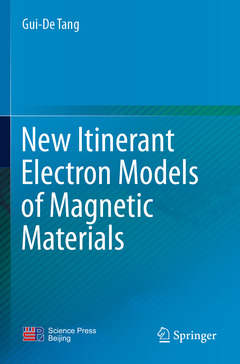References
2. Electron shell structure of free atoms and valence electrons in crystals
2.1 Electron shell structure of free atoms
2.2 A simple introduction to classical crystal binding theory for typical magnetic materials
2.3 Effective radii of ions in crystals
2.4 Electron binding energy originating from ions in crystals
References
3. A simple introduction to basic knowledge of magnetic materials
3.1 Classification of matters based on magnetic properties
3.2 Magnetic domain and domain wall
3.3 Basic parameters of magnetic materials
3.4 Magnetic ordering models in conventional ferromagnetism
References
4. Difficulties related to conventional magnetic ordering models
4.1 Disputes over the distributions of Mn and Cr cations in spinel ferrites
4.2 Difficulties in describing the observed magnetic moments of perovskite manganites
4.3 Relationship between magnetic moment and electrical resistivity in typical magnetic metals
4.4 Puzzle for the origin of magnetic ordering energy
References
5. O 2p itinerant electron model for magnetic oxides
5.1 A simple introduction to early investigations of ionicity
5.2 Study of ionicity of spinel ferrites
5.3 Experimental studies of O 2p holes in oxides
5.4 Study of negative monovalent oxygen ions using X-ray photoelectron spectra
5.5 O 2p itinerant electron model for magnetic oxides (IEO model)
5.6 Relationship between the IEO model and the conventional models
References
6. Magnetic ordering of typical spinel ferrites
6.1 Method fitting magnetic moments of typical spinel ferrites
6.2 Caion distribution characteristics in typical spinel ferrites
References
7. Experimental evidences of the IEO model obtained from spinel ferrite
7.1 Additional antiferromagnetic phase in Ti doped spinel ferrites
7.2 Amplification of spinel ferrite magnetic moment due to Cu substituting for Cr
7.3 Unusual infrared spectra of Cr ferrite
References
8. Spinel ferrites with cant angle magnetic coupling
8.1 Spinel ferrites with Fe ratio being less than 2.0 per molecule
8.2 Spinel ferrites containing nonmagnetic cations
References
9. Magnetic ordering and electrical transport of perovskite manganites
9.1 Ferromagnetic and antiferromagnetic coupling in typical perovskite manganites
9.2 Spin-dependent and spin-independent electrical transport of perovskite manganites
9.3 Experimental evidences on canting magnetic structure in perovskite manganites
9.4 Magnetic coupling between the two sublattices in perovskite praseodymium manganites
9.5 Substituting for Mn in perovskite praseodymium manganites
9.6 Experimental evidences for antiferromagnetic coupling between divalent and trivalent Mn ions in perovskite manganites
References
10. Anti-ferromagnetic ordering in oxides with sodium chloride structure
10.1 Characteristics of antiferromagnetic oxides with sodium chloride structure
10.2 Difference between magnetic structures of manganese monoxide and lanthanum manganite
References
11. Itinerant electron model for magnetic metals
11.1 Experimental and theoretical studies for atomic magnetic moments in metals
11.2 Itinerant electron model for magnetic metals (IEM model)
References
12. Study on the origin of magnetic ordering energy for magnetic materials
12.1 Weiss molecular field
12.2 Thermal expansivity of perovskite manganites near the Curie temperature
12.3 Weiss electron-pair (WEP) model for magnetic ordering energy
12.4 Explanation for the Curie temperature difference of typical magnetic materials
12.5 Explanation for Cu ratio dependence of resistivity and Curie temperature for NiCu alloys
References
13. Prospects and challenges for future work
13.1 Other factors affecting magnetic ordering energy
13.2 Magnetic ordering energy used in DFT calculation
13.3 Application of IEO and IEM model
References
Appendixes
A. Electron structure and ionization energies of free atoms
B. Effective ion radii reported by Shannon
C. Symbol notes




